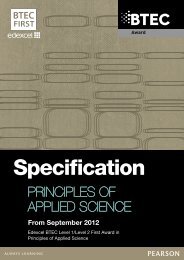BTEC First Award in Application of Science - specification - Edexcel
BTEC First Award in Application of Science - specification - Edexcel
BTEC First Award in Application of Science - specification - Edexcel
Create successful ePaper yourself
Turn your PDF publications into a flip-book with our unique Google optimized e-Paper software.
UNIT 6: APPLICATIONS OF PHYSICAL SCIENCE<br />
Learn<strong>in</strong>g aims and unit content<br />
What needs to be learnt<br />
Learn<strong>in</strong>g aim A: Investigate motion<br />
A.1 Measurement <strong>of</strong> distance and time <strong>in</strong> simple <strong>in</strong>vestigations.<br />
A.2 Use the equation:<br />
distance (m) = speed (m/s) x time (s).<br />
A.3 Use the equation:<br />
displacement (m) = velocity (m/s) x time (s).<br />
A.4 Acceleration relates to a change <strong>in</strong> velocity <strong>of</strong> an object.<br />
A.5 Use the equation:<br />
acceleration (m/s 2 ) = change <strong>in</strong> velocity (m/s) / time taken (s).<br />
A.6 Graphical representations <strong>of</strong> uniform and non-uniform motion (for objects that<br />
are stationary, mov<strong>in</strong>g at a constant speed, mov<strong>in</strong>g with <strong>in</strong>creas<strong>in</strong>g or<br />
decreas<strong>in</strong>g speed).<br />
A.7 Conservation <strong>of</strong> energy <strong>in</strong> simple experiments, <strong>in</strong>clud<strong>in</strong>g energy transformation<br />
diagrams.<br />
A.8 Calculations <strong>of</strong> k<strong>in</strong>etic energy <strong>of</strong> mov<strong>in</strong>g objects <strong>in</strong> simple situations, us<strong>in</strong>g the<br />
follow<strong>in</strong>g equation:<br />
KE = ½ x mass x (speed) 2 .<br />
A.9 Calculate change <strong>in</strong> gravitational potential energy us<strong>in</strong>g the follow<strong>in</strong>g equation:<br />
PE = mass x acceleration due to gravity x change <strong>in</strong> height.<br />
A.10 Energy changes affect<strong>in</strong>g transportation and stopp<strong>in</strong>g distance.<br />
Learn<strong>in</strong>g aim B: Investigate forces<br />
B.1 Forces arise from an <strong>in</strong>teraction between two objects.<br />
B.2 The effect <strong>of</strong> balanced and unbalanced forces on objects.<br />
B.3 Work is done when a force moves through a distance.<br />
B.4 Use the equation:<br />
work done (J) = force (N) x distance (m).<br />
B.5 Use the equation:<br />
force (N) = mass (kg) x acceleration (m/s 2 ).<br />
B.6 Identify ‘pairs’ <strong>of</strong> forces that act on different objects and understand that these<br />
forces are equal <strong>in</strong> size and opposite <strong>in</strong> direction.<br />
B.7 <strong>Application</strong>s <strong>of</strong> compressive and tensile forces.<br />
B.8 Friction and the normal reaction force arise <strong>in</strong> response to an applied force. The<br />
size <strong>of</strong> the frictional force matches the applied force up to a specific limit.<br />
B.9 Forces on a:<br />
a. rocket dur<strong>in</strong>g various stages <strong>of</strong> flight<br />
b. parachutist<br />
c. car dur<strong>in</strong>g brak<strong>in</strong>g and acceleration.<br />
52<br />
BF029957 – Specification – <strong>Edexcel</strong> <strong>BTEC</strong> Level 1/Level 2 <strong>First</strong> <strong>Award</strong> <strong>in</strong> <strong>Application</strong> <strong>of</strong> <strong>Science</strong> –<br />
Issue 1 – March 2012 © Pearson Education Limited 2012








